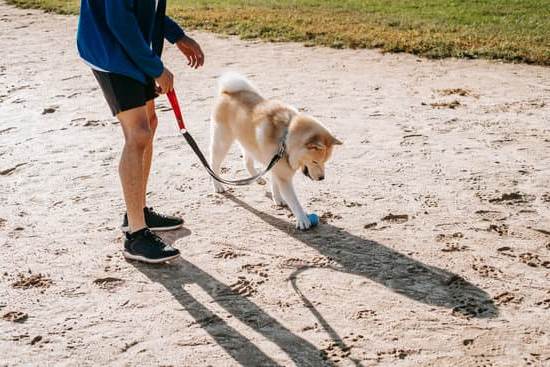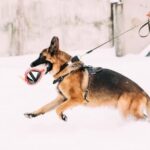Are you wondering how to train a dog to protect a baby? Training your furry friend to be a protector and companion for your little one is an important step in ensuring their safety and forming a strong bond between them.
It’s crucial to understand the significance of properly training a dog to be vigilant and protective, while also maintaining a calm and gentle demeanor around the baby. In this article, we will explore the essential steps and techniques for training your dog to become a loyal guardian for your baby.
Choosing the right dog breed for baby protection is the first important consideration when aiming to train your dog in this capacity. Certain breeds are naturally more inclined towards protective behaviors, making them suitable candidates for this role. We will delve into the qualities and characteristics of different breeds that make them well-suited for protecting babies.
Starting early with training and socializing your dog with the baby is key to creating a harmonious relationship between them. Introducing obedience training, teaching alertness around the baby, and reinforcing positive behavior are all integral parts of this process. Additionally, knowing when to seek professional help and recognizing limitations in your own ability to train your dog can make all the difference in successfully achieving this goal.
Choosing the Right Dog Breed for Baby Protection
When it comes to training a dog to protect a baby, one of the most important considerations is the choice of dog breed. Not all dogs are suitable for this role, and some breeds are naturally more protective and nurturing towards children.
Consideration of Temperament
It is essential to choose a dog breed known for its calm, gentle, and loyal temperament. Breeds such as golden retrievers, boxers, and collies are known for their protective nature and affinity towards children. On the other hand, breeds like pit bulls or rottweilers may have aggressive tendencies that make them unsuitable for this purpose.
Size and Strength
The size and strength of the dog also play a crucial role in their ability to protect a baby. Larger breeds such as German shepherds or mastiffs have the physical prowess to deter potential threats and provide a sense of security.
Training Potential
Some breeds are more receptive to training than others, making them better candidates for learning protective behaviors. Breeds like Doberman pinschers or standard poodles are highly intelligent and trainable, making them ideal for teaching specific protective commands.
Before choosing a specific breed for baby protection, it is important to thoroughly research their characteristics, consult with experienced trainers or breeders, and consider personal preferences and lifestyle factors to ensure compatibility with your family dynamics. Selecting the right dog breed is an essential first step in building a strong, protective bond between your pet and your baby.
Start Early
Training and socializing your dog with the baby is a crucial step in ensuring that your pet will be protective and gentle around the newborn. Here are some important steps to consider when starting early:
- Supervise all interactions between your dog and the baby, ensuring that the dog is calm and gentle in their presence.
- Gradually expose your dog to the sights, sounds, and smells associated with a baby, such as diapers, baby powder, and baby toys.
- Teach your dog basic obedience commands like “sit,” “stay,” and “leave it” to have better control over their behavior around the baby.
It’s important to remember that socialization is key to preventing aggression towards the baby. Exposing your dog to different situations, people, and environments from an early age can help reduce anxiety and fear-based behaviors. In addition to training, regular positive reinforcement through praise, treats, or belly rubs can help create a strong bond between your dog and the new family member.
Another crucial aspect of training and socialization is teaching your dog boundaries around the baby. This can include setting up physical barriers such as baby gates or creating safe spaces where the dog can observe but not directly interact with the infant. Consistency and patience are essential during this process as it may take time for your dog to adjust to these new boundaries.
Teaching Your Dog to Be Alert and Attentive Around the Baby
Understanding the Importance
Teaching your dog to be alert and attentive around the baby is crucial for their safety and well-being. A dog that is tuned in to the baby’s movements and sounds can act as an early warning system, alerting you to any potential dangers or issues. It also helps to create a strong bond between the dog and the baby, fostering a sense of protection and companionship.
Start With Positive Reinforcement
Begin by rewarding your dog for showing interest in the baby. Use treats, praise, and affection to reinforce positive behaviors such as gently sniffing the baby or sitting quietly nearby. This will help your dog associate being around the baby with positive experiences, making them more likely to continue these behaviors in the future.
Setting Boundaries
It’s important to establish boundaries for your dog when it comes to interacting with the baby. Teach them that certain areas or items are off-limits when the baby is present, and discourage behaviors such as jumping up on furniture near the baby. Consistency is key in enforcing these boundaries, so make sure that everyone in the household is on board with these rules.
Introducing Obedience Training to Enhance Protective Behaviors
Obedience training is a crucial aspect of teaching your dog to protect a baby. This type of training not only helps your dog learn basic commands and behaviors, but it also enhances their ability to be protective and attentive around the baby. Start with simple commands such as sit, stay, and come, then gradually introduce more advanced obedience training to strengthen the bond between your dog and the baby.
One effective way to incorporate obedience training for protective behaviors is by using positive reinforcement. Reward your dog with treats or praise when they exhibit attentive and protective behaviors around the baby. This will help them associate protecting the baby with positive experiences, reinforcing their instinct to be watchful and responsive.
Consistency is key when it comes to obedience training for protective behaviors. Practice these commands regularly in different scenarios such as during playtime, mealtime, or walks with the baby. The more consistent you are with the training, the more likely it is that your dog will respond effectively in situations where protection is needed.
| Aspect of Training | Importance |
|---|---|
| Positive Reinforcement | Strengthens the association between protection and positive experiences |
| Consistency | Reinforces learned behaviors in various scenarios |
Practicing Simulated Scenarios to Gauge the Dog’s Reaction
When training a dog to protect a baby, it is crucial to practice simulated scenarios to gauge the dog’s reaction. These exercises can help you assess your dog’s natural protective instincts and identify areas that need improvement. By creating controlled situations that mimic potential threats or dangers to the baby, you can observe how your dog responds and take necessary steps to reinforce positive behavior.
One simulated scenario to consider is having someone approach the baby in a slightly aggressive manner, such as raising their voice or making sudden movements. Observe how your dog reacts in this situation – does it stand alert and position itself between the person and the baby, or does it show signs of fear or aggression? This can provide valuable insight into your dog’s protective instincts and help you address any issues through further training.
Another important simulated scenario involves teaching your dog how to respond when the baby is in distress. By playing recordings of a crying baby or having someone pretend to be distressed, you can observe how your dog reacts and whether it demonstrates the appropriate level of concern and attentiveness. This will allow you to train your dog to respond calmly and reassuringly in these situations, ensuring that it provides comfort and protection for the baby when needed.
Reinforcing Positive Behavior and Discipline Techniques
Once you have started training your dog to protect a baby, it is essential to reinforce positive behavior and implement discipline techniques effectively. Positive reinforcement is key in encouraging the desired protective behaviors in your dog. This can include giving treats, praise, and affection when your dog displays the appropriate protective actions around the baby. By consistently rewarding your dog for their good behavior, they will learn to associate protecting the baby with positive outcomes.
In addition to positive reinforcement, implementing discipline techniques is also crucial in training your dog to protect a baby. This involves setting clear boundaries and rules for your dog to follow. Consistency is key when enforcing these rules, as dogs thrive on routine and structure. Using firm but gentle methods such as redirecting unwanted behaviors and using commands like “No” or “Stop” can help establish a sense of discipline in your dog’s training.
It’s important to note that physical punishment should never be used as a means of discipline in training a dog to protect a baby. Not only does it go against positive reinforcement methods, but it can also lead to aggression or fear-based behaviors in your dog. Always focus on reinforcing positive behaviors and using non-threatening forms of discipline to ensure a healthy and nurturing environment for both your dog and baby.
| Positive Behavior Reinforcement | Discipline Techniques |
|---|---|
| Give treats, praise, and affection | Set clear boundaries and rules |
| Consistently reward good behavior | Use firm but gentle methods |
| Avoid physical punishment | Stay away from aggression-inducing tactics |
When to Seek Professional Help
Training your dog to protect a baby is a serious responsibility that requires careful consideration and proper training. While many dog owners may feel confident in their ability to train and socialize their dogs on their own, there are certain situations where seeking professional help may be necessary.
It’s important to recognize the limitations of your own abilities and the need for external training assistance in order to ensure the safety and well-being of both your dog and your baby.
Here are some signs that indicate it may be time to seek professional help when training your dog to protect a baby:
- Aggressive behavior: If your dog displays signs of aggression towards the baby or others, it’s crucial to seek professional assistance immediately. This behavior can pose a serious risk to the safety of the baby and should not be taken lightly.
- Difficulty in obedience training: If you find that your dog is having difficulty responding to obedience training or is not showing improvement over time, seeking professional help can provide you with additional techniques and strategies to effectively train your dog.
- Unpredictable behavior: Dogs can sometimes exhibit unpredictable behavior, especially in high-stress situations. If you notice that your dog’s behavior around the baby is unpredictable or concerning, consulting with a professional trainer can help address any underlying issues.
Recognizing when to seek professional help is an important part of being a responsible dog owner. Professional trainers have the experience and expertise needed to assess your specific situation and provide personalized guidance for training your dog to protect your baby effectively. Don’t hesitate to reach out for assistance if you encounter challenges or concerns during the training process.
Conclusion
In conclusion, training a dog to protect a baby is an essential step in ensuring the safety and well-being of your child. By choosing the right dog breed, starting early, teaching alertness and obedience, practicing simulated scenarios, and reinforcing positive behavior, you can build a strong and protective bond between your dog and baby. It is important to recognize that this process takes time, patience, and consistency, but the end result is well worth the effort.
Training your dog to protect your baby also involves understanding the limitations and knowing when to seek professional help. While you may be able to handle basic training on your own, recognizing when external assistance is needed is crucial for the safety of both your dog and your baby. Professional trainers can provide additional expertise, guidance, and support in shaping the protective behaviors of your dog.
Ultimately, the goal of training a dog to protect a baby is not just about creating a guard dog, but about fostering a loving and protective relationship between your canine companion and your child. With proper training and care, you can establish a strong bond based on trust and protection that will benefit both your pet and your family for years to come.
Frequently Asked Questions
Will My Dog Be Protective of My Baby?
It depends on the individual dog’s temperament and breed. Some dogs naturally have protective instincts and may exhibit this behavior towards a new baby in the household. However, it’s important to socialize the dog with the baby and set clear boundaries to ensure a safe and positive relationship between them.
How Do I Train My Dog to Be Friendly With My Baby?
Training your dog to be friendly with your baby involves gradual introductions, positive reinforcement, and supervision. Start by teaching basic obedience commands and ensuring the dog understands boundaries around the baby’s space. Offer rewards for calm behavior around the baby and provide plenty of opportunities for positive interactions under supervision.
Can I Train My Dog to Be a Protection Dog?
Yes, it is possible to train certain breeds of dogs to become protection dogs. This type of training should only be done by experienced professionals who understand how to properly channel a dog’s protective instincts without making them overly aggressive. Protection training requires a high level of obedience, control, and specialized skills that not all dogs are suited for.

Welcome to the blog! I am a professional dog trainer and have been working with dogs for many years. In this blog, I will be discussing various topics related to dog training, including tips, tricks, and advice. I hope you find this information helpful and informative. Thanks for reading!





